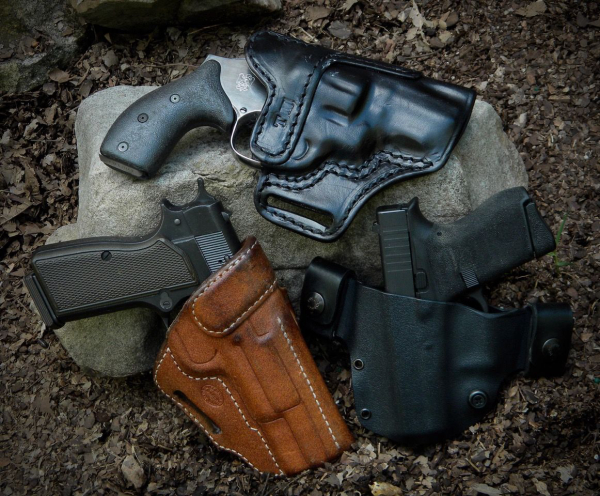
Acquiring a pistol for defense is just your first purchase. For carry you’ll need a proper holster -- and all the other related gear. Many people think holsters are just a place to shove the pistol, but there’s much more to consider. A good holster is hard to find; there’s a lot of personal preference involved. Once you know what a holster should do, discovering your “good” holster is much easier.
Obviously, the holster should secure the pistol; “secure” being the key term. The holster must be made to fit your pistol specifically. With leather, the pistol should fit snugly, especially in the beginning. Kydex holsters flex slightly as the pistol “snaps” into place, and they have tension screws to adjust the fit. Although they have their place, I’m not a fan of retention snaps and such for concealed carry. It should require some force to draw the pistol, but not so much that you have to hold the holster down with the support hand. You also don’t want a situation where once the pistol pulls clear of the rig, the force you had to use slings it across the parking lot.
The ability to holster with one hand is mandatory. An empty holster should hold its shape, open and ready when you decide to holster. A holster that collapses after drawing, requiring you to use the support hand to open up to secure the pistol is unacceptable. This is especially true for IWB’s – inside the waistband holsters.
The holster has to fit the pistol, but it also has to fit your hand. Acquiring a proper firing grip prior to drawing the pistol is essential. That’s the foundation for everything that happens once the weapon clears the holster. One of the biggest problems I see with holsters on the range is the inability to establish the firing grip with pistol holstered. The shooter’s knuckles won’t fit between the grip and holster. Part of the holster prevents the shooter’s thumb from wrapping around the grip. The angle of the holster may prevent the shooter from getting the gun hand positioned properly. Don’t quit looking until you’ve got the holster that allows that proper grip.
For semi-auto pistols, the holster is also used to cycle the slide during single-hand manipulations. Hand and arm injuries are common in fights – cuts, hits, breaks and shot. Malfunctions occur more often in fights than on the range. It’s often a failure to seat the magazine or cycle the slide aggressively. I practice single hand manipulations a lot, as if my life might depend on these skills. For strong hand operation of the pistol, it’s a great advantage to be able to hook the rear sight on the holster to cycle the action, or use the holster to strip out a stuck magazine.
Obviously, comfort is a factor. As well as concealability. Keep in mind that men’s and women’s bodies are shaped differently. There are holsters designed specifically to fit women’s bodies. Finding your holster usually takes a lot of experimentation. Everyone I know has a box of leather and kydex that didn’t make the cut. What doesn’t work for you may be just right for someone else. Sell it and move on. The best advice is, don’t stop the search, experimenting or testing until you discover your “good” holster. This applies to all other kit, too.
Tiger McKee is director of Shootrite Firearms Academy. He is the author of The Book of Two Guns, AR-15 Skills and Drills, has a regular column in American Handgunner and makes some cool knives and custom revolvers. Visit Shootrite’s Facebook page for other details.
